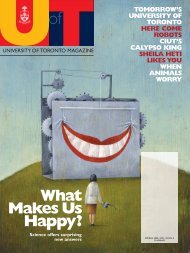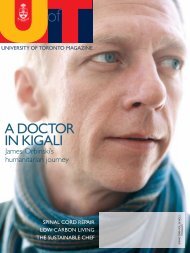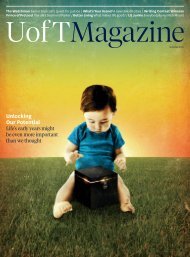The Next Big Idea 10 concepts that could - University of Toronto ...
The Next Big Idea 10 concepts that could - University of Toronto ...
The Next Big Idea 10 concepts that could - University of Toronto ...
You also want an ePaper? Increase the reach of your titles
YUMPU automatically turns print PDFs into web optimized ePapers that Google loves.
All about Alumni<br />
Breathing Lessons<br />
Nurse Almir Alicelebic brings an<br />
element <strong>of</strong> kung fu to the bedside<br />
Overheard<br />
A man arrives in the ER with a racing heartbeat. A nurse takes the<br />
man’s pulse. It’s over 150, well above the normal range <strong>of</strong> 60 to<br />
<strong>10</strong>0 beats per minute.<br />
At the Weeneebayko hospital in Moose Factory, Ontario,<br />
nurse Almir Alicelebic (BScN 2009) not only provides the appropriate<br />
care for atrial fibrillation, he teaches the patient how to<br />
slow down his frantic heartbeat with a Kungrobics breathing<br />
technique. He also refers the patient to his weekly Kungrobics<br />
class, which he holds at a health centre.<br />
Alicelebic learned Kungrobics in <strong>Toronto</strong>, and the practice emphasizes the breath work<br />
used in kung fu training. Alicelebic, 25, finds <strong>that</strong> it promotes health and fosters feelings<br />
<strong>of</strong> well-being. As a nursing student, he introduced Kungrobics to Na-Me-Res, a shelter in<br />
<strong>Toronto</strong> for native men. “<strong>The</strong> breathing exercises were quite successful for some <strong>of</strong> the<br />
residents, especially ones <strong>of</strong>f the street with cravings, anxiety and non-clinical depression,”<br />
says Alicelebic, noting <strong>that</strong> a treatment program is also necessary for people dealing with<br />
cravings. At the end <strong>of</strong> his placement, he taught Kungrobics to a First Nations counsellor<br />
at the shelter to ensure the practice <strong>could</strong> continue. <strong>The</strong> counsellor thought the movements<br />
resembled those <strong>of</strong> the animal spirits depicted in traditional native dances.<br />
“My favourite successes come from the bedside,” continues Alicelebic, who has<br />
<strong>of</strong>fered the breathing exercises to patients battling everything from arthritis to suicidal<br />
feelings. He is now hoping to work with a physician to integrate Kungrobics into the<br />
Weeneebayko hospital’s traditional healing program.<br />
Five years ago, when Alicelebic started studying Kungrobics, he just wanted to<br />
learn a martial art. “I had no idea to what extent it would shift my perception, morality<br />
and outlook on life,” he says. “I’ve been extending this sort <strong>of</strong> thinking into my everyday<br />
life, and I’ve been noticing more while being happy with less.” – Susan Pedwell<br />
On CSI, all deaths<br />
are murders. In Ontario,<br />
most people die <strong>of</strong><br />
natural diseases. Of the<br />
approximately 80,000<br />
deaths <strong>that</strong> occur in a<br />
year in Ontario, only<br />
about 250 altogether<br />
across the province are<br />
suspicious or homicides.<br />
Dr. Toby Rose, a forensic<br />
pathologist, highlighting<br />
one media distortion <strong>of</strong> her<br />
pr<strong>of</strong>ession. Rose trained<br />
in pathology at U <strong>of</strong> T. She<br />
spoke at ideaCity in <strong>Toronto</strong><br />
last June.<br />
also marks the 64-year-old Environics co-founder<br />
as a card-carrying boomer. “If I were to be zapped by<br />
a Vespa jaywalking across Bloor Street today, I would be happy<br />
to have ended my authorial career with this book,” he says.<br />
“If I manage to dodge <strong>that</strong> Vespa, then I will continue to work<br />
for the rest <strong>of</strong> my life as long as it does not feel like work.”<br />
On a sunny fall day, he’s fuming (still) about the Conservative<br />
Party’s decision to scrap the long-form census. Adams<br />
is also full <strong>of</strong> talk about his latest venture, the four-year-old<br />
Environics Institute for Survey Research. Its aim is “to stimulate<br />
constructive discourse” based on public-opinion research<br />
geared at specific groups, such as Muslims and aboriginals,<br />
who tend not to be the subject <strong>of</strong> values surveys.<br />
Adams’ previous titles probed and prodded the body politic;<br />
his bestseller Fire and Ice definitively laid to rest the notion <strong>that</strong><br />
Canadians are simply Americans with snow shovels at the ready.<br />
In Stayin’ Alive, he divides the boomers into four “values” tribes,<br />
reasoning <strong>that</strong> people’s beliefs shape our opinions to external<br />
forces at least as powerfully as more traditional categories (age,<br />
region, party affiliation). He slots himself into the “Autonomous<br />
Rebel” tribe – which most closely resembles the prevailing<br />
stereotype <strong>of</strong> the boomer as a countercultural hippie.<br />
Looking ahead to the boomers’ dotage, Adams doesn’t<br />
expect the much-studied generation born between 1946 and<br />
1964 to make a sharp right turn into reactionary old age.<br />
<strong>The</strong> boomers, his findings further indicate, are not morphing<br />
into their parents, and the progressive values <strong>of</strong> their youth<br />
remain intact. “<strong>The</strong> Autonomous Rebel at 60 looks like the<br />
Autonomous Rebel at 40,” he says. “We’re becoming more<br />
like ourselves.” – John Lorinc<br />
courtesy <strong>of</strong> almir alicelebic<br />
48 WWW.MAGAZINE.UTORONTO.CA
















